 ,11Department of Physics,
,11Department of Physics, 2School of Nuclear Sicence and Engineering,
Received:2020-07-30Revised:2020-09-28Accepted:2020-11-4Online:2021-02-04

Abstract
Keywords:
PDF (1027KB)MetadataMetricsRelated articlesExportEndNote|Ris|BibtexFavorite
Cite this article
Hui-Juan Wang, Zun-Yan Di, Zhi-Gang Wang. Analysis of the excited Ωc states as the $\tfrac{1}{2}$± pentaquark states with QCD sum rules. Communications in Theoretical Physics, 2021, 73(3): 035201- doi:10.1088/1572-9494/abc7b1
1. Introduction
In 2017, five new narrow excited Ωc states named Ωc(3000), Ωc(3050), Ωc(3066), Ωc(3090) and Ωc(3119) were observed in the LHCb collaboration [1]. These new observed hadrons were reported to be the excited states of Ωc which is composed of one c quark and two s quarks. The decay widths of these states were also measured, which were only a few MeV. However, the quantum numbers of theses excited states are not confirmed until now.The above discovery inspired a large amount of theoretical studies of these excited Ωc states with different asssumptions of their structures. Conventionally, these states were interpreted in three-quark frames [2–13] and assigned as the orbitally or radially excited states of the Ωc baryons. In [9], the authors employed the QCD sum rules on the light-cone to study the decay properties of Ωc baryons and assigned Ωc(3000), Ωc(3050) and Ωc(3119) to be $\left(1P,{\tfrac{1}{2}}^{-}\right)$, $\left(1P,{\tfrac{3}{2}}^{-}\right)$ and $\left(2S,{\tfrac{3}{2}}^{+}\right)$, respectively. In [10], the authors assigned Ωc(3066) and Ωc(3119) as the 2S states, and used the QCD sum rules to calculate the masses of these states. In [11], the authors employed the 3p0 model to study the decay widths of the charmed baryons and interpreted Ωc(3066) and Ωc(3090) to be 1P-wave with ${J}^{P}={\tfrac{3}{2}}^{-}$ and ${\tfrac{5}{2}}^{-}$, respectively. The possibility of the assignment of the 1D-wave states were also discussed in [11]. In [12], we assigned Ωc(3000) and Ωc(3119) to be $\left(1P,{\tfrac{1}{2}}^{-}\right)$ and $\left(2S,{\tfrac{3}{2}}^{+}\right)$, respectively, and assigned Ωc(3090) to be $\left(1P,{\tfrac{3}{2}}^{-}\right)$ or $(2S,{\tfrac{1}{2}}^{+})$. In [13], our calculation predicted Ωc(3000), Ωc(3050), Ωc(3066), Ωc(3090) and Ωc(3119) to be the P-wave baryon states with ${J}^{P}={\tfrac{1}{2}}^{-}$, ${\tfrac{1}{2}}^{-}$, ${\tfrac{3}{2}}^{-}$, ${\tfrac{3}{2}}^{-}$ and ${\tfrac{5}{2}}^{-}$, respectively.
In 2015, the LHCb reported the exotic structure Pc(4450) which also has a narrow decay width of 39±5±19 MeV [14]. In [15], the analysis of the low-lying pentaquark states with S=−3 and negative parity indicated that baryon excitation by pulling out a $q\overline{q}$ pair may need less energy than by the tranditional orbital excitation. The ground states of Ωc are Ωc(2695) and Ωc(2770) with spin-parity ${J}^{P}={\tfrac{1}{2}}^{+}$ and ${\tfrac{3}{2}}^{+}$ which had been observed experimentally. The mass gaps between the excited Ωc states and the ground states are 230–424 MeV, which are large enough to excite a light quark-antiquark pair. It means these excited states can be the multiquark candidates.
Kim et al proposed Ωc(3050) and Ωc(3119) to be exotic pentaquarks with ${J}^{P}={\tfrac{1}{2}}^{+}$ and ${\tfrac{3}{2}}^{+}$, respectively, in the chiral quark-soliton model. The calculation of the strong decays of Ωc(3050) and Ωc(3119) supported the assignment and naturally explained the LHCb obsevation that Ωc(3050) and Ωc(3119) have anomalously small widths [16]. In [17], the investigation found that the pentaquark configurations take sizable probabilities in these Ωc baryons. Yang and Ping studied both the three-quark system with ssc and the five-quark system with ${sscu}\overline{u}$ and ${sscd}\overline{d}$ by performing the dynamical calculation of Ωc in the framework of the chiral quark model [18]. Those excited states were also considered as candidates of molecular states [19–21]. In [22], we designed these excited states as axialvector-diquark-scalar-diquark-antiquark type charmed pentaquark states with ${J}^{P}={\tfrac{3}{2}}^{\pm }$.
In our previous work, we have ever assigned the five Ωc states as conventional three-quark baryon states [12, 13] and axialvector-diquark-scalar-diquark-antiquark type charmed pentaquark states [22]. A hadron could have a lot of Fock states, which can couple to different interpolating currents with certain quantum numbers. Up to now, the mass spectrums of these Ωc states were not determined, we can construct different three-quark and pentaquark interpolating currents to investigate the inner structures of these hadrons. In the present work, in order to explore the possible interpretation of pentaquark states for these Ωc states, we construct both the scalar-diquark-scalar-diquark-antiquark type and axialvector-diquark-axialvector-diquark-antiquark type interpolating currents to study the charmed pentaquark states ${susc}\bar{u}$ with ${J}^{P}={\tfrac{1}{2}}^{\pm }$. By considering the vacuum condensates up to dimension 13 we investigated the masses and pole residues of the charmed pentaquark states through the QCD sum rules. Comparing the results with the measurement of LHCb, it is found that the scalar-diquark-scalar-diquark-antiquark type and axialvector-diquark-axialvector-diquark-antiquark type charmed pentaquark states ${susc}\bar{u}$ with ${J}^{P}={\tfrac{1}{2}}^{-}$ can be possible candidates of the excited Ωc states observed in the LHCb collaboration.
2. QCD sum rules for the ${\tfrac{1}{2}}^{\pm }$ charmed pentaquark states
The two-point correlation function in QCD rum rules is written as followAt the phenomenological side, a complete set of intermediate pentaquark states with the same quantum numbers as the current operators J(x) and iγ5J(x) are inserted into the correlation functions Π(p) to obtain the hadronic representation [23]. The result is obtained as follow after isolating the lowest states with ${J}^{P}={\tfrac{1}{2}}^{\pm }$.
The currents J(0) couple potentially to the charmed pentaquark states with ${J}^{P}={\tfrac{1}{2}}^{\pm }$ [24]
Based on dispersion relation, we can obtain the hadronic spectral densities at the phenomenological side
We can obtain the QCD sum rules at the hadron side by introducing the weight function $\exp \left(-\tfrac{s}{{T}^{2}}\right)$,
We briefly outline the operator product expansion for the correlation functions Π1,2(p). Using Wick theorem we contract the s, u and c quark fields in the correlation function Π1,2(p) and obtain the results as follow:
After obtaining the QCD spectral densities ${\rho }_{\mathrm{QCD}}^{1}(s)$ and ${\rho }_{\mathrm{QCD}}^{0}(s)$, we take the quark-hadron duality below the continuum threshold parameter s0 and introduce the weight function $\exp \left(-\tfrac{s}{{T}^{2}}\right)$ to obtain the QCD sum rules:
The QCD sum rules can be rewritten clearly as follow
We derive equation (
3. Numerical results and discussions
In our calculation, the vacuum condensates values are taken as ${m}_{0}^{2}=(0.8\pm 0.1){\mathrm{GeV}}^{2}$, $\langle \bar{s}s\rangle =(0.8\pm 0.1)\langle \bar{q}q\rangle $, $\langle \bar{q}q\rangle \,=-{(0.24\pm 0.01\mathrm{GeV})}^{3}$, $\langle \bar{q}{g}_{s}\sigma {Gq}\rangle ={m}_{0}^{2}\langle \bar{q}q\rangle $, $\langle \bar{s}{g}_{s}\sigma {Gs}\rangle \,={m}_{0}^{2}\langle \bar{s}s\rangle $, $\left\langle \tfrac{{\alpha }_{s}{GG}}{\pi }\right\rangle ={(0.33\mathrm{GeV})}^{4}$ at the energy scale μ=1 GeV [23], The quark condensate and the mixed quark condensate evolve with the renormalization group equation [28, 29]We have ever discussed how to choose the optimal energy scale and suggested an energy scale formula $\sqrt{{M}_{P}^{2}-{(2{{\mathbb{M}}}_{Q})}^{2}}$ to study hidden charmed (bottom) tetraquark states, pentaquark states and molecular states in the QCD rum rules in details [24–27]. The effective Q-quark masses ${{\mathbb{M}}}_{Q}$ embody the net effect of the complex dynamics and have universal values [24–27]. In this paper, we rewrite the energy scale formula as $\mu =\sqrt{{M}_{P}^{2}-{{\mathbb{M}}}_{c}^{2}}$, because there exists only one c quark, and take the effective c-quark mass ${{\mathbb{M}}}_{c}=1.82\,\mathrm{GeV}$ [33].
Here, we study the charmed pentaquark states with three types of energy scale parameters. Firstly, we evolve the input parameters to the energy scale $\mu =\sqrt{{M}_{P}^{2}-{{\mathbb{M}}}_{c}^{2}}$ to extract the masses MP. Then, we evolve the input parameters to the energy scale μ=1 GeV to extract the masses MP [34, 35]. Finally, we evolve the input parameters except for mc(mc) to the energy scale μ=1GeV to extract the masses MP which is denoted as $\mu =\overline{1.0}\,\mathrm{GeV}$ [36, 37].
We can determine the ideal Borel parameter T2 and continuum threshold parameter s0 according to three criteria. The first criterion is pole dominance at the hadron side. The optimal energy scale μ, ideal Borel parameter T2, continuum threshold parameter s0 and pole contribution are shown in table 1. From table 1, we can see that the pole contributions are approximately in the range of 40%–60% and pole dominance at the hadron side can be satisfied. The values $\sqrt{{s}_{0}}={M}_{{P}_{c}({\tfrac{1}{2}}^{\pm })}+(0.4-0.6)\mathrm{GeV}$ can lead to satisfactory results [38–40]. In this work, the pole contributions PC is defined as follow
Table 1.
Table 1.The optimal energy scale μ, Borel parameter T2, continuum threshold parameter s0 and pole contributions for the charmed pentaquark states.
| JP | μ(GeV) | T2 (GeV2) | $\sqrt{{s}_{0}}(\mathrm{GeV})$ | Pole | |
|---|---|---|---|---|---|
| ${susc}{\bar{u}}_{1}$ | ${\tfrac{1}{2}}^{-}$ | 2.5 | 1.9–2.3 | 3.6±0.1 | (40−68)% |
| 1.0 | 2.8−3.2 | 4.6±0.1 | (41−64)% | ||
| $\overline{1.0}$ | 2.8−3.2 | 4.5±0.1 | (39−62)% | ||
| ${susc}{\bar{u}}_{2}$ | ${\tfrac{1}{2}}^{-}$ | 2.6 | 2.0−2.4 | 3.7±0.1 | (37−66)% |
| 1.0 | 2.7−3.1 | 4.6±0.1 | (40−63)% | ||
| $\overline{1.0}$ | 2.6−3.0 | 4.5±0.1 | (41−65)% | ||
| ${susc}{\bar{u}}_{1}$ | ${\tfrac{1}{2}}^{+}$ | 4.3 | 3.3−3.7 | 5.2±0.1 | (43−63)% |
| 1.0 | 3.4−3.8 | 5.3±0.1 | (40−61)% | ||
| $\overline{1.0}$ | 3.4−3.8 | 5.3±0.1 | (42−63)% | ||
| ${susc}{\bar{u}}_{2}$ | ${\tfrac{1}{2}}^{+}$ | 4.3 | 3.1−3.5 | 5.2±0.1 | (40−61)% |
| 1.0 | 3.2−3.6 | 5.3±0.1 | (41−62)% | ||
| $\overline{1.0}$ | 3.3−3.7 | 5.3±0.1 | (41−62)% | ||
New window|CSV
The second criterion is convergence of the operator product expansion. The absolute contributions of the vacuum condensates ∣D(n)∣ for the central values dependent on the energy scale parameter $\mu =\sqrt{{M}_{P}^{2}-{{\mathbb{M}}}_{c}^{2}}$ are shown in figure 1. D(n) is defined as
Figure 1.
 New window|Download| PPT slide
New window|Download| PPT slideFigure 1.The absolute contributions of the vacuum condensates of dimension n for central values dependent on the energy scale $\mu =\sqrt{{M}_{P}^{2}-{{\mathbb{M}}}_{c}^{2}}$, where (I) and (II) denote ${susc}{\bar{u}}_{1}$ and ${susc}{\bar{u}}_{2}$, respectively, (a) and (b) correspond to ${J}^{P}={\tfrac{1}{2}}^{-}$ and ${\tfrac{1}{2}}^{+}$, respectively.
The third criterion is Borel platforms figures 2–7 show the masses and pole residues distribution with the variations of the Borel parameter T2 at much larger intervals than the Borel windows as shown in table 1. It can be clearly seen that the uncertainties of the masses and pole residues from the Borel parameter T2 in the Borel windows are very small, therefore, the Borel platforms exist. Now the three criteria are all satisfied.
Figure 2.
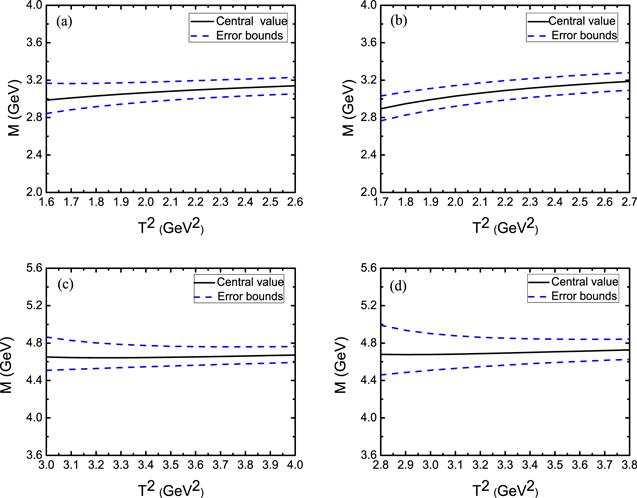 New window|Download| PPT slide
New window|Download| PPT slideFigure 2.The masses of the charmed pentaquark states with variations of the Borel parameter T2 dependent on the energy scale $\mu =\sqrt{{M}_{P}^{2}-{{\mathbb{M}}}_{c}^{2}}$, where (a)–(d) correspond to $\left({susc}{\bar{u}}_{1},{\tfrac{1}{2}}^{-}\right)$, $\left({susc}{\bar{u}}_{2},{\tfrac{1}{2}}^{-}\right)$, $\left({susc}{\bar{u}}_{1},{\tfrac{1}{2}}^{+}\right)$, and $\left({susc}{\bar{u}}_{2},{\tfrac{1}{2}}^{+}\right)$, respectively.
Figure 3.
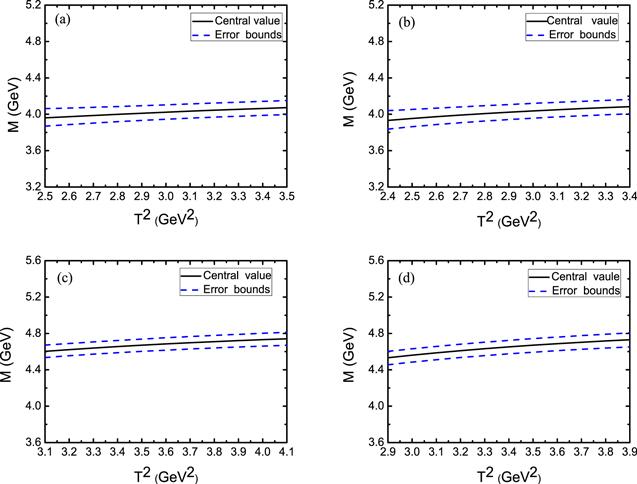 New window|Download| PPT slide
New window|Download| PPT slideFigure 3.The masses of the charmed pentaquark states with variations of the Borel parameter T2 dependent on the enery scale μ=1 GeV, where (a)–(d) correspond to $\left({susc}{\bar{u}}_{1},{\tfrac{1}{2}}^{-}\right)$, $\left({susc}{\bar{u}}_{2},{\tfrac{1}{2}}^{-}\right)$, $\left({susc}{\bar{u}}_{1},{\tfrac{1}{2}}^{+}\right)$, and $\left({susc}{\bar{u}}_{2},{\tfrac{1}{2}}^{+}\right)$, respectively.
Figure 4.
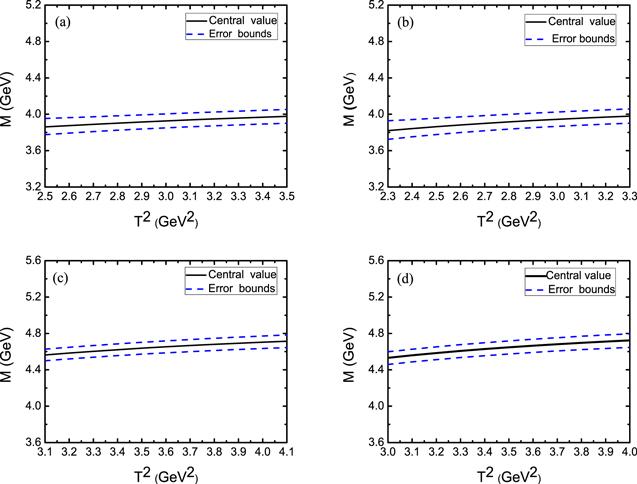 New window|Download| PPT slide
New window|Download| PPT slideFigure 4.The masses of the charmed pentaquark states with variations of the Borel parameter T2 dependent on the enery scale $\mu =\overline{1.0}\,\mathrm{GeV}$, where (a)–(d) correspond to $\left({susc}{\bar{u}}_{1},{\tfrac{1}{2}}^{-}\right)$, $\left({susc}{\bar{u}}_{2},{\tfrac{1}{2}}^{-}\right)$, $\left({susc}{\bar{u}}_{1},{\tfrac{1}{2}}^{+}\right)$, and $\left({susc}{\bar{u}}_{2},{\tfrac{1}{2}}^{+}\right)$, respectively.
Figure 5.
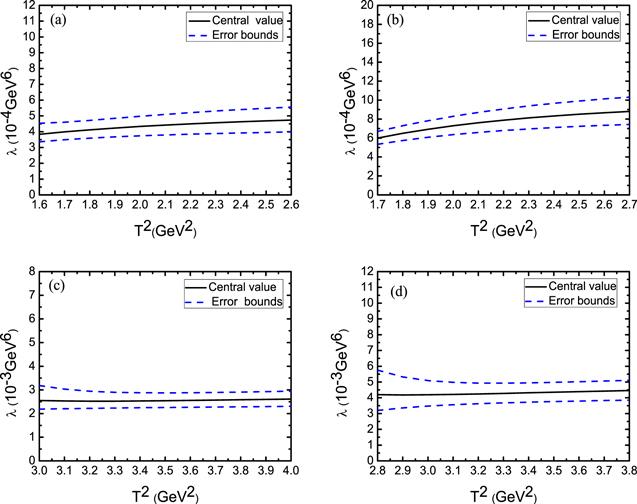 New window|Download| PPT slide
New window|Download| PPT slideFigure 5.The pole residues of the charmed pentaquark states with variations of the Borel parameter T2 dependent on the energy scale $\mu =\sqrt{{M}_{P}^{2}-{{\mathbb{M}}}_{c}^{2}}$, where (a)–(d) correspond to $\left({susc}{\bar{u}}_{1},{\tfrac{1}{2}}^{-}\right)$, $\left({susc}{\bar{u}}_{2},{\tfrac{1}{2}}^{-}\right)$, $\left({susc}{\bar{u}}_{1},{\tfrac{1}{2}}^{+}\right)$, and $\left({susc}{\bar{u}}_{2},{\tfrac{1}{2}}^{+}\right)$, respectively.
Figure 6.
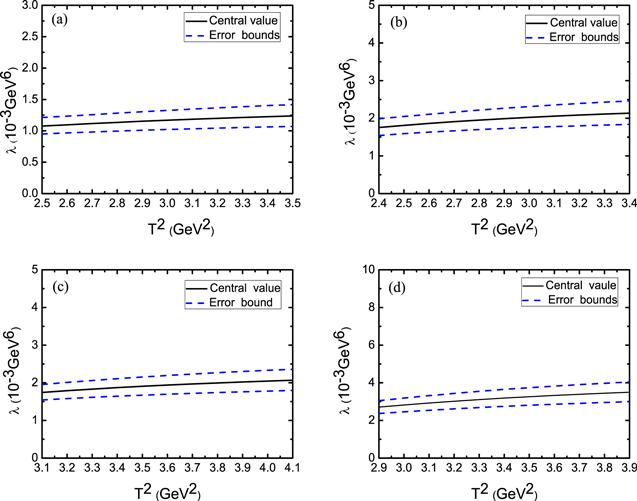 New window|Download| PPT slide
New window|Download| PPT slideFigure 6.The pole residues of the charmed pentaquark states with variations of the Borel parameter T2 dependent on the enery scale μ=1 GeV, where (a)–(d) correspond to $\left({susc}{\bar{u}}_{1},{\tfrac{1}{2}}^{-}\right)$, $\left({susc}{\bar{u}}_{2},{\tfrac{1}{2}}^{-}\right)$, $\left({susc}{\bar{u}}_{1},{\tfrac{1}{2}}^{+}\right)$, and $\left({susc}{\bar{u}}_{2},{\tfrac{1}{2}}^{+}\right)$, respectively.
Figure 7.
 New window|Download| PPT slide
New window|Download| PPT slideFigure 7.The pole residues of the charmed pentaquark states with variations of the Borel parameter T2 dependent on the enery scale $\mu =\overline{1.0}\,\mathrm{GeV}$, where (a)–(d) correspond to $\left({susc}{\bar{u}}_{1},{\tfrac{1}{2}}^{-}\right)$, $\left({susc}{\bar{u}}_{2},{\tfrac{1}{2}}^{-}\right)$, $\left({susc}{\bar{u}}_{1},{\tfrac{1}{2}}^{+}\right)$, and $\left({susc}{\bar{u}}_{2},{\tfrac{1}{2}}^{+}\right)$, respectively.
Figure 8 shows the masses distribution with the Borel parameter for central values on a large scale dependent on the energy scale $\mu =\sqrt{{M}_{P}^{2}-{{\mathbb{M}}}_{c}^{2}}$. It is seen that the predicted masses increase slowly with the Borel parameter for the negative parity. For the positive parity the predicted masses decrease slowly with the Borel parameter. It warrants the appearance of good Borel platforms.
Figure 8.
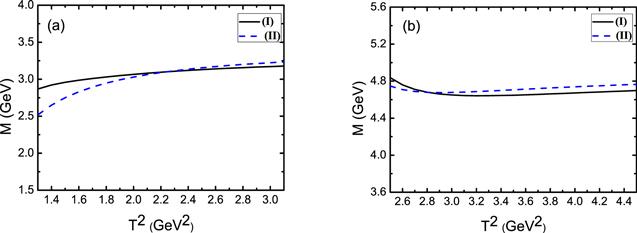 New window|Download| PPT slide
New window|Download| PPT slideFigure 8.The predicted masses with variations of the Borel parameter for central values dependent on the energy scale $\mu =\sqrt{{M}_{P}^{2}-{{\mathbb{M}}}_{c}^{2}}$, where (I) and (II) denote the pentaquark states ${susc}{\bar{u}}_{1}$ and ${susc}{\bar{u}}_{2}$, respectively, (a) and (b) correspond to ${J}^{P}={\tfrac{1}{2}}^{-}$ and ${\tfrac{1}{2}}^{+}$, respectively.
Considering all uncertainties of the parameters, we obtain the masses and pole residues of the charmed pentaquark states with ${J}^{P}={\tfrac{1}{2}}^{\pm }$ based on three types of energy scale parameters as shown in table 2. It is seen that the predicted masses of the charmed pentaquark states ${susc}{\bar{u}}_{1}$ and ${susc}{\bar{u}}_{2}$ with ${J}^{P}={\tfrac{1}{2}}^{-}$ dependent on the energy scale parameter $\mu =\sqrt{{M}_{P}^{2}-{{\mathbb{M}}}_{c}^{2}}$ are ${3.08}_{-0.14}^{+0.12}\,\mathrm{GeV}$ and ${3.09}_{-0.17}^{+0.14}\,\mathrm{GeV}$ respectively, which are in consistent with the experiment data of the LHCb collaboration [1]. The masses of the charmed pentaquark states ${susc}{\bar{u}}_{1}$ and ${susc}{\bar{u}}_{2}$ with ${J}^{P}={\tfrac{1}{2}}^{+}$ dependent on the energy scale parameter $\mu =\sqrt{{M}_{P}^{2}-{{\mathbb{M}}}_{c}^{2}}$ are ${4.65}_{-0.11}^{+0.11}\,\mathrm{GeV}$ and ${4.69}_{-0.16}^{+0.15}\,\mathrm{GeV}$ respectively, which have large deviation to the five new excited states. The predicated masses based on the other two kinds of energy scale parameters are larger than that based on the energy scale formula $\mu =\sqrt{{M}_{P}^{2}-{{\mathbb{M}}}_{c}^{2}}$.
Table 2.
Table 2.The predicted masses and pole residues of the charmed pentaquark states.
| JP | μ(GeV) | M (GeV) | λ (GeV6) | |
|---|---|---|---|---|
| ${susc}{\bar{u}}_{1}$ | ${\tfrac{1}{2}}^{-}$ | 2.5 | ${3.08}_{-0.14}^{+0.12}$ | ${4.42}_{-0.75}^{+0.89}\times {10}^{-4}$ |
| 1.0 | ${4.02}_{-0.10}^{+0.10}$ | ${1.17}_{-0.17}^{+0.20}\times {10}^{-3}$ | ||
| $\overline{1.0}$ | ${3.93}_{-0.10}^{+0.09}$ | ${1.16}_{-0.17}^{+0.19}\times {10}^{-3}$ | ||
| ${susc}{\bar{u}}_{2}$ | ${\tfrac{1}{2}}^{-}$ | 2.6 | ${3.09}_{-0.17}^{+0.14}$ | ${7.88}_{-1.52}^{+1.78}\times {10}^{-4}$ |
| 1.0 | ${4.02}_{-0.11}^{+0.11}$ | ${1.99}_{-0.32}^{+0.36}\times {10}^{-3}$ | ||
| $\overline{1.0}$ | ${3.92}_{-0.12}^{+0.10}$ | ${1.95}_{-0.31}^{+0.35}\times {10}^{-3}$ | ||
| ${susc}{\bar{u}}_{1}$ | ${\tfrac{1}{2}}^{+}$ | 4.3 | ${4.65}_{-0.11}^{+0.11}$ | ${2.54}_{-0.31}^{+0.35}\times {10}^{-3}$ |
| 1.0 | ${4.68}_{-0.09}^{+0.10}$ | ${1.94}_{-0.30}^{+0.33}\times {10}^{-3}$ | ||
| $\overline{1.0}$ | ${4.65}_{-0.09}^{+0.10}$ | ${2.17}_{-0.32}^{+0.35}\times {10}^{-3}$ | ||
| ${susc}{\bar{u}}_{2}$ | ${\tfrac{1}{2}}^{+}$ | 4.3 | ${4.69}_{-0.16}^{+0.15}$ | ${4.28}_{-0.72}^{+0.70}\times {10}^{-3}$ |
| 1.0 | ${4.65}_{-0.12}^{+0.11}$ | ${3.19}_{-0.57}^{+0.64}\times {10}^{-3}$ | ||
| $\overline{1.0}$ | ${4.65}_{-0.12}^{+0.10}$ | ${3.70}_{-0.62}^{+0.69}\times {10}^{-3}$ | ||
New window|CSV
The predicted uncertainties originate from the input parameters, such as the effective c-quark mass ${{\mathbb{M}}}_{c}$, the continuum threshold parameter s0, and the vacuum condensate values ${m}_{0}^{2}$, $\langle \bar{s}s\rangle $ and $\langle \bar{q}q\rangle $, in which the parameters s0 and ${m}_{0}^{2}$ cause main uncertainties. For example, for the charmed pentaquark states ${susc}{\bar{u}}_{1}$ with ${J}^{P}={\tfrac{1}{2}}^{-}$, the uncertainties from s0 and ${m}_{0}^{2}$ are ${}_{-0.08}^{+0.09}\mathrm{GeV}$ and ${}_{-0.11}^{+0.09}\mathrm{GeV}$, respectively.
From table 2, we can see that the masses of the negative-parity pentaquark states from two different interpolating currents lie in the same region. Generally speaking, an interpolating current can couple to a hadron or several hadrons or a hadron system or several hadron systems if they have the same quantum numbers, as the non-vanishing couplings are not forbidden by the symmetries. On the other hand, a hadron maybe have many Fock states, a Fock state couples potentially to an interpolating current with the same quantum numbers as the Fock state. Therefore, the present calculations could indicate that a pentaquark state owns two different inner structures, or two pentaquark states have masses in the same region. More experimental and theoretical works are still needed to make a solid assignment. In addition, it is found that the mass gaps between the positive-parity pentaquark states and the corresponding negative-parity pentaquark states are more than 1.5 GeV. If the positive-parity pentaquark states are the orbitally excited states of the negative-parity ones, the mass splittings seem too large because the energy costs exciting an orbital angular momentum are approximately 300–600 MeV. However, our calculation results are obtained based on the quantum chromodynamics, which are different from the ones based on the quark model, the positive-parity pentaquark states are not necessarily the orbitally excited states of the negative-parity ones. The currents J1(x) and J2(x) have negative-parity, they also couple potentially to the positive-parity pentaquark states, as multiplying iγ5 to the currents to change their parity [40–43].
For the positive-parity pentaquark states, the contribution of the vacuum condensate of dimension n in the QCD spectral density ${\rho }_{{\rm{QCD}}}^{1}(s)$ with n≥3 is canceled out with the corresponding ones in the QCD spectral density ${\rho }_{{\rm{QCD}}}^{0}(s)$ to a great extent due to the combination $\sqrt{s}{\rho }_{{\rm{QCD}}}^{1}(s)-{\rho }_{{\rm{QCD}}}^{0}(s)$, the operator product expansion converges very well at all the energy scales μ≥1 GeV. In such a case, the energy scale formula $\mu =\sqrt{{M}_{P}^{2}-{{\mathbb{M}}}_{c}^{2}}$ can only improve the pole contributions mildly and enhance the operator product expansion convergence mildly, therefore the predicted pentaquark masses depend on the energy scales of the QCD spectral densities mildly. For the negative-parity pentaquark states, the contribution of the vacuum condensate of dimension n in the QCD spectral density ${\rho }_{{\rm{QCD}}}^{1}(s)$ with n≥3 is strengthened by the corresponding ones in the QCD spectral density ${\rho }_{{\rm{QCD}}}^{0}(s)$ due to the combination $\sqrt{s}{\rho }_{{\rm{QCD}}}^{1}(s)+{\rho }_{{\rm{QCD}}}^{0}(s)$, the operator product expansion converges very slow. In this case, the energy scale formula $\mu =\sqrt{{M}_{P}^{2}-{{\mathbb{M}}}_{c}^{2}}$ can improve the pole contributions remarkably and enhance the operator product expansion convergence remarkably, we prefer the energy scale formula $\mu =\sqrt{{M}_{P}^{2}-{{\mathbb{M}}}_{c}^{2}}$ to choose the best energy scales of the QCD spectral densities to obtain the ideal Borel windows to extract the pentaquark masses, as the predictions vary considerably with variations of the Borel windows.
4. Conclusion
In this work, we construct both the scalar-diquark-scalar-diquark-antiquark type and axialvector-diquark-axialvector-diquark-antiquark type interpolating currents to study the charmed pentaquark states ${susc}\bar{u}$ with ${J}^{P}={\tfrac{1}{2}}^{\pm }$. We employ three types of energy scale parameters to investigate the masses and pole residues of the charmed pentaquark states using the QCD sum rules. By comparing these results with experiment data, we find that if we take pole contributions in the scope of 40%–60% we can get more reasonable prediction using the energy scale formula $\mu =\sqrt{{M}_{P}^{2}-{{\mathbb{M}}}_{c}^{2}}$ than the other two types of energy scale parameters. The energy scale formula $\mu =\sqrt{{M}_{P}^{2}-{{\mathbb{M}}}_{c}^{2}}$ can improve the pole contributions dramatically and enhance the operator product expansion convergence remarkably, especially for the negative parity states. Hence, we prefer the energy scale formula $\mu =\sqrt{{M}_{P}^{2}-{{\mathbb{M}}}_{c}^{2}}$ in this work. Our calculation results support assigning the new excited Ωc states to be the scalar-diquark-scalar-diquark-antiquark type and axialvector-diquark-axialvector-diquark-antiquark type charmed pentaquark states ${susc}\bar{u}$ with ${J}^{P}={\tfrac{1}{2}}^{-}$. It indicates that the pentaquark configuration can be possible interpretation of the new narrow excited states observed in the LHCb collaboration.We group the flavor parts as $({su})-({sc})-\bar{u}$ to construct the interpolating currents here. If we group the flavor parts as $({ss})-({cu})-\bar{u}$ to construct the scalar-diquark-scalar-diquark-antiquark type interpolating current, which is non-existent according to fermi statistics. We can construct axialvector-diquark-axialvector-diquark-antiquark type interpolating current by grouping the flavor parts as $({ss})-({cu})-\bar{u}$. The result should approximately equal to that by grouping the flavor parts as $({su})-({sc})-\bar{u}$ according to the SU(3) symmetry. Further calculation is still needed to make a solid conlcusion.
Acknowledgments
This work is supported by National Natural Science Foundation, Grant Number 11775079.Reference By original order
By published year
By cited within times
By Impact factor
DOI:10.1103/PhysRevLett.118.182001 [Cited within: 2]
DOI:10.1103/PhysRevD.96.014024 [Cited within: 1]
DOI:10.1103/PhysRevD.95.094018
DOI:10.1103/PhysRevD.95.094008
DOI:10.1103/PhysRevD.96.094015
DOI:10.1103/PhysRevD.95.114012
DOI:10.1103/PhysRevD.95.116010
DOI:10.1103/PhysRevLett.119.042001
DOI:10.1140/epjc/s10052-017-4953-z [Cited within: 1]
DOI:10.1209/0295-5075/118/61001 [Cited within: 1]
DOI:10.1103/PhysRevD.95.114024 [Cited within: 2]
DOI:10.1140/epjc/s10052-017-5409-1 [Cited within: 2]
DOI:10.1140/epjc/s10052-017-4895-5 [Cited within: 3]
DOI:10.1103/PhysRevLett.115.072001 [Cited within: 1]
DOI:10.1103/PhysRevC.87.025205 [Cited within: 1]
DOI:10.1103/PhysRevD.96.094021 [Cited within: 1]
DOI:10.1103/PhysRevD.96.034012 [Cited within: 1]
DOI:10.1103/PhysRevD.97.034023 [Cited within: 1]
DOI:10.1103/PhysRevD.97.094013 [Cited within: 1]
DOI:10.1140/epjc/s10052-018-5874-1
DOI:10.1103/PhysRevD.97.034027 [Cited within: 1]
DOI:10.1140/epjc/s10052-018-5989-4 [Cited within: 3]
DOI:10.1016/0370-1573(85)90065-1 [Cited within: 4]
DOI:10.1140/epjc/s10052-016-3880-8 [Cited within: 4]
DOI:10.1140/epjc/s10052-016-3880-8 [Cited within: 4]
DOI:10.1140/epjc/s10052-017-5514-1 [Cited within: 1]
DOI:10.1016/j.nuclphysa.2014.08.084
DOI:10.1140/epjc/s10052-014-2874-7 [Cited within: 3]
DOI:10.1142/S0217751X20500037 [Cited within: 1]
DOI:10.1088/1674-1137/44/6/063105 [Cited within: 1]
DOI:10.1088/1674-1137/40/10/100001 [Cited within: 2]
DOI:10.1016/0370-2693(83)91271-6
DOI:10.1017/CBO9780511535000 [Cited within: 1]
DOI:10.1140/epjc/s10052-016-4238-y [Cited within: 1]
DOI:10.1140/epjc/s10052-010-1447-7 [Cited within: 1]
DOI:10.1140/epjc/s10052-009-1156-2 [Cited within: 1]
DOI:10.1103/PhysRevD.75.014005 [Cited within: 1]
DOI:10.1016/j.physletb.2006.06.054 [Cited within: 1]
DOI:10.1140/epja/i2011-11081-8 [Cited within: 1]
DOI:10.1088/0253-6102/58/5/17
DOI:10.1140/epjc/s10052-010-1365-8 [Cited within: 2]
DOI:10.1016/0550-3213(82)90154-7
DOI:10.1016/0370-2693(93)90696-F
DOI:10.1103/PhysRevD.54.4532 [Cited within: 1]
